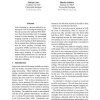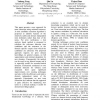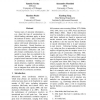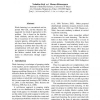COLING
2008
14 years 1 months ago
2008
We propose an approach to natural language inference based on a model of natural logic, which identifies valid inferences by their lexical and syntactic features, without full sem...
COLING
2008
14 years 1 months ago
2008
Active learning is a proven method for reducing the cost of creating the training sets that are necessary for statistical NLP. However, there has been little work on stopping crit...
COLING
2008
14 years 1 months ago
2008
We describe and evaluate a new method of automatic seed word selection for unsupervised sentiment classification of product reviews in Chinese. The whole method is unsupervised an...
COLING
2008
14 years 1 months ago
2008
This paper explores the use of the homotopy method for training a semi-supervised Hidden Markov Model (HMM) used for sequence labeling. We provide a novel polynomial-time algorith...
COLING
2008
14 years 1 months ago
2008
COLING
2008
14 years 1 months ago
2008
Various types of structural information e.g., about the type of constructions in which binding constraints apply, or about the structure of names - play a central role in corefere...
COLING
2008
14 years 1 months ago
2008
COLING
2008
14 years 1 months ago
2008
Within the area of general-purpose finegrained subjectivity analysis, opinion topic identification has, to date, received little attention due to both the difficulty of the task a...
COLING
2008
14 years 1 months ago
2008
Word clustering is a conventional and important NLP task, and the literature has suggested two kinds of approaches to this problem. One is based on the distributional similarity a...
COLING
2008
14 years 1 months ago
2008
We present procedures which pool lexical information estimated from unlabeled data via the Inside-Outside algorithm, with lexical information from a treebank PCFG. The procedures ...




